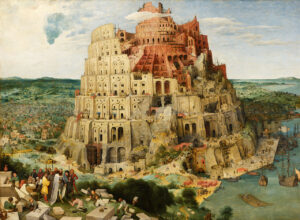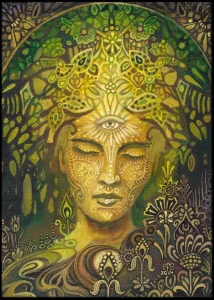 When the human animal developed an ego our species began a long, slow separation from Nature. What was once a guilt-free ride in the unconscious maternal matrix where instinct ruled, unchallenged, became an arduous trek through the tangled jungles of fear, guilt, self-torment, and self-doubt. For the first time we reflected on the consequences of acting on our obsessive urges. We discovered the values of planning ahead and using self-restraint. And we bowed in respect to the rare members of our tribes who demonstrated the benefits of living with these and other new skills.
When the human animal developed an ego our species began a long, slow separation from Nature. What was once a guilt-free ride in the unconscious maternal matrix where instinct ruled, unchallenged, became an arduous trek through the tangled jungles of fear, guilt, self-torment, and self-doubt. For the first time we reflected on the consequences of acting on our obsessive urges. We discovered the values of planning ahead and using self-restraint. And we bowed in respect to the rare members of our tribes who demonstrated the benefits of living with these and other new skills.
Something miraculous was happening to us. No longer were we merely crude instinctual vessels whose only aims were procreation and survival. We were evolving into consciousness.This is the metaphorical meaning of the Old Testament story of the tower of Babel (Genesis 11: 1-9).
At that time all mankind spoke a single language. As the population grew and spread eastward, a plain was discovered in the land of Babylon, and was soon thickly populated. The people who lived there began to talk about building a great city, with a temple-tower reaching to the skies—a proud, eternal monument to themselves.
“This will weld us together,’ they said…But when God came down to see the city and the tower mankind was making, he said, ‘Look! If they are able to accomplish all this when they have just begun to exploit their linguistic and political unity, just think of what they will do later! Nothing will be unattainable for them! Come, let us go down and give them different languages so that they won’t understand each other’s words!” (The Living Bible Paraphrased. Carmel, New York: Guideposts Associates, Inc. 1971, p. 8)
In this story the people are hoping to re-create the golden paradise of unity in which they luxuriated before they became self-aware. But the jealous Old Testament God has a very different perspective. He sees their wish as prideful and self-centered just as he sees Eve’s desire to know the difference between good and evil as selfish and disobedient. So he punishes them by separating them from all that feels familiar and safe and cursing them with the confusion and mistrust that naturally arise between different cultures.
But who is the “us” God refers to when he says, “…let us go down and give them different languages so that they won’t understand each other’s words”?
An even more problematic question is,“Why would God want to confuse humanity?” Could this really be the intent of an authentically benevolent deity or has another, unconscious force been shaping our ideas and stories about God?
Let’s begin with my first question. In Biblical, Apocryphal and Gnostic traditions, Sophia symbolized God’s Wisdom. In Judaism the Shechinah was God’s female persona.
 Feminine wisdom was the partner of the God of logos from the beginning, but we saw less of her as the ego grew stronger in its grand march through the ages. The reason for this lies in the natural development of our psyches. If consciousness was evolution’s gift to us, dualism was its curse. Recognizing our choices gave rise to conscience and moral responsibility, and we became conflict-ridden crucibles of transformation. What had once been a unified, albeit unconscious psyche, was changing into a house divided against itself. And as we changed, our God-images changed.
Feminine wisdom was the partner of the God of logos from the beginning, but we saw less of her as the ego grew stronger in its grand march through the ages. The reason for this lies in the natural development of our psyches. If consciousness was evolution’s gift to us, dualism was its curse. Recognizing our choices gave rise to conscience and moral responsibility, and we became conflict-ridden crucibles of transformation. What had once been a unified, albeit unconscious psyche, was changing into a house divided against itself. And as we changed, our God-images changed.
This was the situation at the stage of the ego’s growth represented by the story of the Tower of Babel. Our species had long been banished from Eden’s paradise of childhood innocence and had evolved into conflicted teenagers. One part of us yearned to return to the comforts of unconsciousness and irresponsibility, the other wanted to push on to express our individuality. To the young ego, both choices were profoundly attractive, and both were intolerable.
Was it really a jealous God who wanted to confuse and separate humanity? Or was this God-image the creation of a confused adolescent ego? In fact, dualistic thinking was separating us from our original sense of unity and part of us wanted to preserve it by “erecting a monument” to it. But to the other part, returning to the unconscious state it associated with the maternal matrix felt like death!
So the fearful, ambitious part of our ego took the lead and aligned itself primarily with “masculine” values like toughness, goal-oriented striving, separating, discriminating, and individuating, and projected these values onto a masculine Sky God of logos. Correspondingly it disowned “feminine” values, and to escape its guilt about abandoning Great Mother, it assumed “God made me do it!”
Jungian analyst Marion Woodman described the feminine principle In an interview with Robert Johnson:
The feminine principle attempts to relate. Instead of breaking things off into parts, it says, Where are we alike? How can we connect? Where is the love? Can you listen to me? Can you really hear what I am saying? Can you see me? Do you care whether you see me or not?
Next time, Mandorla Consciousness, Part II.
Note: This post and the next one (both are slightly edited here) were originally published by the Center for Action and Contemplation under the title, The Mandorla Consciousness. Radical Grace, Summer 2012, vol. 25, no 3, p. 18.
Image Credits: Google Images, Tower of Babel, Pieter Bruegel the Elder. Etsy, Sophia Goddess of Wisdom
Jean Raffa’s The Bridge to Wholeness and Dream Theatres of the Soul are at Amazon. Healing the Sacred Divide can be found at Amazon and Larson Publications, Inc. Jean’s new Nautilus Award-winning The Soul’s Twins, is at Amazon and Schiffer’s Red Feather Mind, Body, Spirit. Subscribe to her newsletter at www.jeanbenedictraffa.com.






15 Responses
Reblogged this on lampmagician.
Many thanks for reposting this.
I’ve seen the picture in the flesh, so to speak, when it was on exhibition in the British Museum, a special thing on Babylon.
Excellent post.
What a treat! It’s a magnificent painting, isn’t it? I’m glad you enjoyed this post. Hope you like the next one as well, and thank you for stopping by.
“as” well. ?
Fascinating interpretations. I have done Shechinah paintings. Love this concept. Thanks.
Thanks, Diane. I’ve seen some of those gorgeous paintings. Love them!!! Do you have any examples posted online? If so, send a link so we can see them.
Thanks Jeannie – They were all babbling in self – aggrandisement of their egos as a monument to themselves is my first thought. Perhaps there was an over striving for unity as they all spoke the same language, had the same goals, and there was a need for diversity and thus the need to drive them further afield, scattered like seeds upon the earth. I don’t know –
If Sophia or Shekinah were part of the ‘us’ who decided to confound them, we must wonder at their purpose. This was still in Genesis when the world was young and there was so much to learn in this world of duality. Perhaps it was too soon for the population to build the gate to G-d. As you say, still at the adolescent stage. Like those before them, they had to learn about exile and in time to return to unity, but not before their time …? I don’t know.
Along the way, duality became further entrenched and it became an us and them, black and white, good and evil … and (too) much got relegated into the background. But hopefully because of more awareness of the fertility of the Great Mother who always replenishes herself, there is hope that logos and eros can be re-united for the healing of all that is wounded.
Yes. And yes. And yes.? Thanks for the thoughtful and apt commetary on these ideas. I agree.
Does Jesus fit into this perspective?
Don Cain
Yes. If we see Jesus as the Christian exemplar of humanity’s potential for psycho-spiritual development into consciousness, wholeness and enlightenment, as I do, he does, indeed. He shows us that we, too, can transcend our inner and outer divides by choosing “to live fully, love wastefully, and be all that we can be” to use a definition I learned from Bushop John Spong. If he, being fully human, and at the same time fully divine, could do that, so can we. But since this is an Old Testament story from the book of Genesis, which was written some time between 1500-1300 BC, Jesus wouldn’t have been born.
Thank you, Jeanie. It helps so much to have a conscious structure to guide where we’ve been and how humanity went off track. The craving to be powerful and god-like is so tempting for a flimsy ego. We seem to have to be pushed to the edge to understand we are exiled from our own wholeness. You always see the positive potential of the mess. Thank you for that.
Thanks, Elaine. It helps me to trace the history of current issues, particularly ones that influence the psychological and spiritual aspects of human growth. There have been so many detours and dead-ends in our process of awakening that have had a negative impact for thousands of years at a time. I keep hoping we’ll learn from our mistakes, and I believe we are, but it takes a very long time to create every tiny change in our societies and ourselves.
So here’s my positive take on “the mess” we’re in now: When I compare our attitudes and behaviors, both personal and cultural, to those from the earliest days of recorded history, I see a great deal of growth in consciousness. We cannot stop the evolution of our species: neither the physical nor the mental. It will happen, no matter how hard we fight it and how much we stereotype and persecute otherness. Every generation will have its issues to try to resolve, and the resolutions may not come for many more generations, but they will come. There is hope for us.
Dear Jeanie,
I really enjoyed this post, especially Susan and Elaine’s responses! Your words feel so relevant today as I sense those bewildering Babylonian days have descended again. I think Susan hit the nail on its head with her recognition of the need for diversity, bringing in what had been exiled for centuries. We went off track, Elaine says, and the temptation to be powerful and godlike is so tempting for an inflated ego that craves admiration and importance. Alas, pushed to those limits, we exile ‘ourselves’ from our own ‘wholeness’.
I agree we cannot stop the evolution of our species but thank goodness there are writers like yourself and Marion Woodman who are able to articulate these inner and outer events and find a common language, free of jargon, so that many are able to understand. This makes so much sense in light of Generation Z’s very conscious (above) exploration of gender ID together with psychology’s very divided exploration (below) of androgyny and finding that balance of the Divine Feminine and Divine Masculine. I share your hope.
Love and light, Deborah.
Dear Deborah, I think there are many lessons to be learned from the story of the tower of Babel: a very early and apt metaphor for the predicaments we still struggle with today. Certainly one of them is that there are always forces beyond our control that can thwart our ego’s “best laid plans”; a reminder that “pride goeth before a fall.” Another is that conflict and suffering are inevitable. A third is that repressing or oppressing any kind of “otherness” that threatens our egos only aggravates the situation.
Your reference to the necessity to unite both what’s “above” (heady power-driven ego consciousness) and “below” (heartfelt relationships between our conscious and conscious selves, as well as between self and others) pretty much sums up the human problem, one that always involves both the sacred and the profane. Resolution will only emerge as each of us struggles to reunite ‘ourselves’ with our own ‘wholeness.’ Thank you for writing. Your comments always inspire my search for new distinctions and connections.
Love, Jeanie